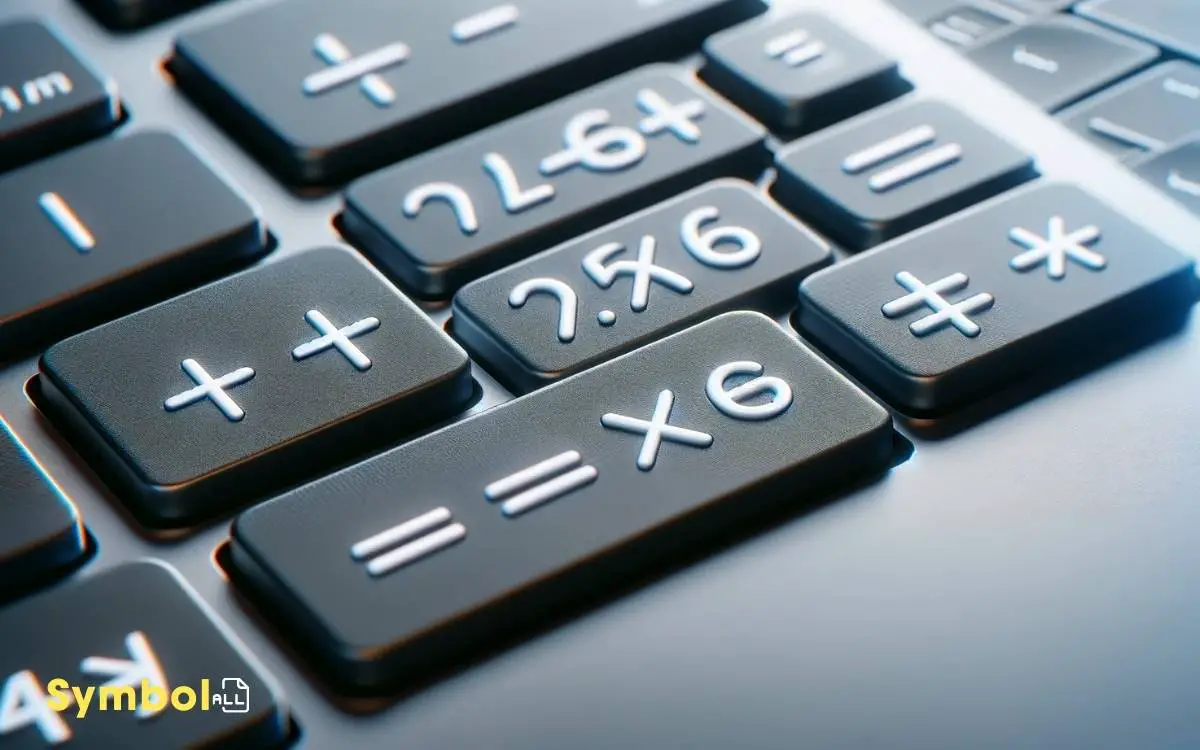How to Use Math Symbols on Keyboard? Alt Key Codes!
You can easily use math symbols on your keyboard with a few tips. First, make sure your Num Lock is on to use Alt key codes for symbols like π (Alt+227) or ± (Alt+241).
On Windows, the Character Map offers a visual selection of symbols, while Mac users can explore the Character Viewer. For more specific needs, learning shortcut keys and Unicode can speed up your typing.
If you’re always on the go, familiarize yourself with mobile keyboard tricks for quick symbol access. Customizing shortcuts for frequent symbols can greatly boost your efficiency.
By mastering these techniques, you’ll navigate mathematical expressions with ease and uncover even more ways to streamline your work.

Key Takeaways
Understanding Keyboard Layouts
Before delving into the specifics of using math symbols, it’s crucial to familiarize yourself with the various keyboard layouts available.
You’ll primarily encounter two types: QWERTY, used mostly in the Americas and Western Europe, and AZERTY, predominant in French-speaking countries.
Each layout arranges letters, numbers, and symbols differently, impacting how you access math symbols.
For instance, accessing basic math symbols like plus (+), minus (-), equals (=), and division (/) could vary slightly between layouts. It’s also worth noting that some symbols might require using the Shift key or other modifier keys.
Understanding your keyboard layout ensures you’re not left puzzled when instructions for entering math symbols don’t seem to match your keyboard’s configuration.
Using the Alt Key Codes
You can access a wide range of math symbols on your keyboard by mastering the use of Alt key codes. To begin, make sure Num Lock is on. Hold down the Alt key and type the appropriate code on the numeric keypad.
For example, Alt + 0177 gives you the plus-minus symbol (±). Remember, these codes work primarily on Windows systems. Each symbol has a unique code—Alt + 0181 for the micro symbol (µ), and Alt + 0176 for the degree symbol (°), among others.
This method allows for quick insertion of mathematical symbols without browsing through menus. Practice these codes to enhance your efficiency in typing mathematical documents or performing related tasks.
Utilizing the Character Map
While mastering Alt key codes is a useful skill, exploring the Character Map on Windows provides another method to access math symbols easily. This utility displays a broad range of characters available in various fonts, including numerous mathematical symbols. You can search for specific symbols, copy them to your clipboard, and use them in your documents or projects. For instance, if you’re looking up instructions on how to make a heart symbol, the Character Map allows you to select it directly rather than relying on remembering key codes. This tool is particularly handy for users who need a visual reference or prefer not to memorize shortcuts.
To open it, search for ‘Character Map’ in the Start menu. Once open, you’ll find an extensive list of characters. You can select the desired symbol, then copy and paste it into your document.
Remember to check the ‘Advanced view‘ box to search for symbols by name, making it easier to find specific math symbols.
This tool is particularly valuable if you frequently use a wide variety of symbols that are hard to remember or if you prefer a more visual selection method.
Shortcut Keys for Common Symbols
Let’s immerse ourselves in the world of shortcut keys, which offer a quick and efficient way to insert common math symbols into your documents. Using these shortcuts not only speeds up your workflow but also enhances your typing accuracy.
Here’s how you can get started:
- For the Plus or Minus Symbol (±): Press `Alt` + `0177` on your numeric keypad.
- To Insert the Pi Symbol (π): Hold down the `Alt` key and type `227` on your numeric keypad.
- For the Square Root Symbol (√): Use `Alt` + `251` on your numeric keypad.
These shortcuts work primarily on Windows platforms. Remember, the numeric keypad is essential for these shortcuts, so they mightn’t work on laptops without one. This approach streamlines your math-related tasks, making them more manageable and efficient.
Incorporating Unicode Characters
Next, you’ll learn how to incorporate Unicode characters to access a wider range of math symbols.
You’ll start by understanding the basics of Unicode, ensuring you can find and use the exact symbols you need.
Understanding Unicode Basics
Diving into Unicode basics, you’ll discover it’s a universal character encoding standard that allows you to incorporate a vast array of math symbols and other characters into your documents.
This system is essential for anyone looking to enhance their work with precise mathematical expressions or symbols from various languages.
Here’s what makes Unicode indispensable:
- Universal Compatibility: Works across different platforms, ensuring your symbols appear the same on any device.
- Extensive Library: Offers over 143,000 characters covering multiple languages and symbols, including a wide range of math symbols.
- Ease of Use: Though it might seem challenging, once you grasp the basics, using Unicode becomes straightforward, empowering you to precisely convey complex mathematical ideas.
Understanding these fundamentals will greatly enhance your ability to communicate effectively in academic or professional settings.
Accessing Math Symbols
To access math symbols using Unicode characters, you’ll need to understand how to incorporate these into your documents efficiently.
First, locate the Unicode number associated with the symbol you want to use. This can be found in Unicode tables available online.
Once you have the code, the method to insert the symbol varies depending on your operating system.
On Windows, you’ll often use the Alt key combined with the numeric code on the numeric keypad. For Mac users, it’s a bit different; you’ll use the Option key plus a specific character sequence.
Unicode Implementation Tips
Incorporating Unicode characters in your documents can greatly enhance their clarity and effectiveness. When you’re dealing with complex mathematical expressions, utilizing these characters guarantees your work is understood universally.
Here’s how to seamlessly integrate Unicode characters:
- Use Character Map on Windows or Character Viewer on Mac – These tools allow you to find and insert any Unicode character easily.
- Learn Shortcuts – Familiarize yourself with keyboard shortcuts for common symbols to speed up your workflow.
- Utilize Online Resources – Websites like Unicode Table provide a detailed list of symbols. Copy and paste the characters directly into your document.
Leveraging Microsoft Word Shortcuts
You’ll find Microsoft Word shortcuts incredibly useful for inserting math symbols without the hassle.
A quick press of specific keys allows you to add equations seamlessly into your documents.
Let’s explore how these shortcuts streamline your workflow and enhance your productivity.
Shortcut Keys Overview
Leveraging Microsoft Word shortcuts can considerably streamline your workflow when incorporating math symbols into your documents. These keyboard shortcuts can help you input common mathematical symbols quickly, without interrupting your thought process.
Here’s a brief overview of essential shortcuts you should know:
- Alt + =: This triggers the equation field, where you can start typing your equation directly.
- Ctrl + Shift + +: Use this combination to create superscripts, handy for exponents or abbreviations.
- Ctrl + =: This shortcut creates subscripts, perfect for chemical formulas or mathematical notations.
Understanding and using these shortcuts can enhance your efficiency, allowing you to focus more on the content rather than on how to input specific symbols. They’re straightforward, easy to remember, and you’ll find they quickly become second nature with a bit of practice.
Inserting Equations Quickly
Building on the basics of keyboard shortcuts, let’s explore how to insert equations quickly in Microsoft Word to further enhance your document preparation efficiency.
If you’re working on a document that requires mathematical expressions, you don’t have to navigate through menus manually. Simply press “Alt” + “=” on your keyboard. This shortcut immediately brings up the equation editor, where you can input your formula directly.
For complex equations, you can type keywords like “ rac” for fractions, followed by space, which Word converts into the corresponding symbols automatically.
Exploring LaTeX for Complex Equations
Immersing yourself in LaTeX enables you to efficiently craft complex equations that standard keyboard inputs can’t handle. This typesetting system is a powerful tool for generating high-quality scientific and mathematical documents.
Here’s how to get started:
- Learn Basic Syntax: Start with understanding commands (\) for symbols, curly braces ({}) for grouping, and square brackets ([]) for optional arguments.
- Practice with Online Editors: Utilize online LaTeX editors to experiment and see immediate results. This hands-on approach accelerates your learning curve.
- Explore Packages: Immerse yourself in the vast library of LaTeX packages. They offer pre-defined commands for specific fields, such as physics or algebra, making your equation writing more efficient.
Accessing Symbols on Mac
Shifting from LaTeX, it’s time to explore how you can access various math symbols directly on your Mac. On a Mac, accessing math symbols is straightforward.
Start by opening the ‘Character Viewer‘ – press Control + Command + Spacebar. This tool provides a wide array of symbols, including mathematical ones.
You can browse through categories or use the search bar to find specific symbols. For frequently used symbols, like the square root or pi, you can add these to your ‘Favorites‘ for quicker access in the future. Additionally, some symbols can be typed using keyboard shortcuts.
For instance, pressing Option + 2 will type the trademark symbol. Remember, the exact keystrokes might vary, so experimenting or checking Mac’s documentation can be helpful.
Mobile Keyboard Tips
When you’re typing on a mobile keyboard, accessing math symbols quickly can be a game-changer for efficiency.
Here are a few tips to streamline your typing:
- Long-press keys: Many mobile keyboards hide math symbols behind a long press on certain keys. For example, holding down the letter ‘E’ might reveal the euro symbol (€).
- Swipe to access: Some keyboards allow you to swipe from a specific key to enter a symbol quickly. It’s worth exploring your keyboard’s features to discover these shortcuts.
- Numeric keypad: Switching to the numeric keypad often reveals commonly used symbols like the plus (+), minus (-), multiplication (×), and division (÷) signs, making them more accessible.
Mastering these tips can greatly enhance your typing speed and efficiency on mobile devices.
Customizing Shortcuts
Customizing shortcuts on your keyboard allows you to tailor your typing experience for greater efficiency and speed. By setting up specific combinations for frequently used math symbols, you’re not only saving time but also making your work process smoother.
This customization can be done through your operating system’s settings or specialized keyboard software that supports macro creation.
Start by identifying the math symbols you use most often. Then, assign them to unique key combinations that are important to choose combinations that are easy to remember and comfortable to type.
Testing your new shortcuts guarantees they work as intended and don’t interfere with other applications. With practice, these custom shortcuts will become second nature, enhancing your productivity when typing mathematical expressions.
Browser Extensions for Math Symbols
While setting up keyboard shortcuts offers a personalized way to insert math symbols, exploring browser extensions can further simplify this process for you.
These tools are designed to enhance your online experience, making it quick and effortless to include complex mathematical expressions in your documents and emails.
Here’s a look at three notable extensions:
- MathJax Plugin for Github: Renders mathematical symbols and equations directly on web pages, useful for academic and research documentation.
- TeX All the Things: Allows you to use TeX/LaTeX commands for math symbols on most websites, including social media platforms.
- Math Anywhere: Automatically converts TeX equations into readable math symbols on any website, ideal for browsing academic papers or educational content.
These extensions not only save time but also improve your workflow by integrating seamlessly with your browser.
Troubleshooting Common Issues
Despite your best efforts, you might encounter issues when trying to use math symbols with your keyboard. If symbols aren’t appearing as expected, first check your keyboard layout settings.
You might’ve accidentally switched to a different layout where symbol shortcuts vary. Also, confirm Num Lock is on for numeric keypad shortcuts.
For software-specific problems, such as in word processors or web browsers, verify that you’re using the latest version. Updates often fix symbol input glitches.
If you’re relying on browser extensions for math symbols, make sure they’re enabled and updated. Sometimes, conflicts with other extensions can cause issues, so try disabling others temporarily to test.
Lastly, if all else fails, consider using an online math symbol keyboard as an alternative. These platforms are designed to bypass many common issues found in traditional input methods.
Conclusion
In a digital world where math is a universal language, mastering the art of typing math symbols on your keyboard is like discovering a treasure chest of knowledge. Remember, practice makes perfect.
Immerse yourself in the sea of Alt codes, navigate through the character map, and don’t hesitate to customize shortcuts that work like magic for you. With these tools at your fingertips, you’ll be solving equations on your screen as smoothly as pen dances on paper.
Keep experimenting and happy typing!






